Abstract
Dissociation constants (KA) and relative efficacies of acetylcholine, (+)-methacholine and (-)-methacholine at muscarinic receptors in the guinea-pig isolated ileum were determined in the absence and presence of the cholinesterase inhibitor diisopropylfluorophosphate. The method used involved analysis of dose-response data before and after fractional inactivation of receptors with propylbenzilylcholine mustard. The KA values, estimated after cholinesterase inhibition, of acetylcholine, (+)- and (-)-methacholine were 1.7, 2.0 and 620 microM, respectively. The large (730 fold) difference in spasmogenic activity between (+)- and (-)-methacholine is due primarily to a difference in affinity for ileal muscarinic receptors although differences in efficacy (2 to 4 fold) also contribute. It is suggested that the methyl group at the chiral centre of (+)-methacholine has no apparent effect on the binding to muscarinic receptors, whereas the corresponding methyl group of (-)-methacholine interferes with binding, presumably by stabilizing a conformation of the drug which does not fit the receptor very well.
Full text
PDF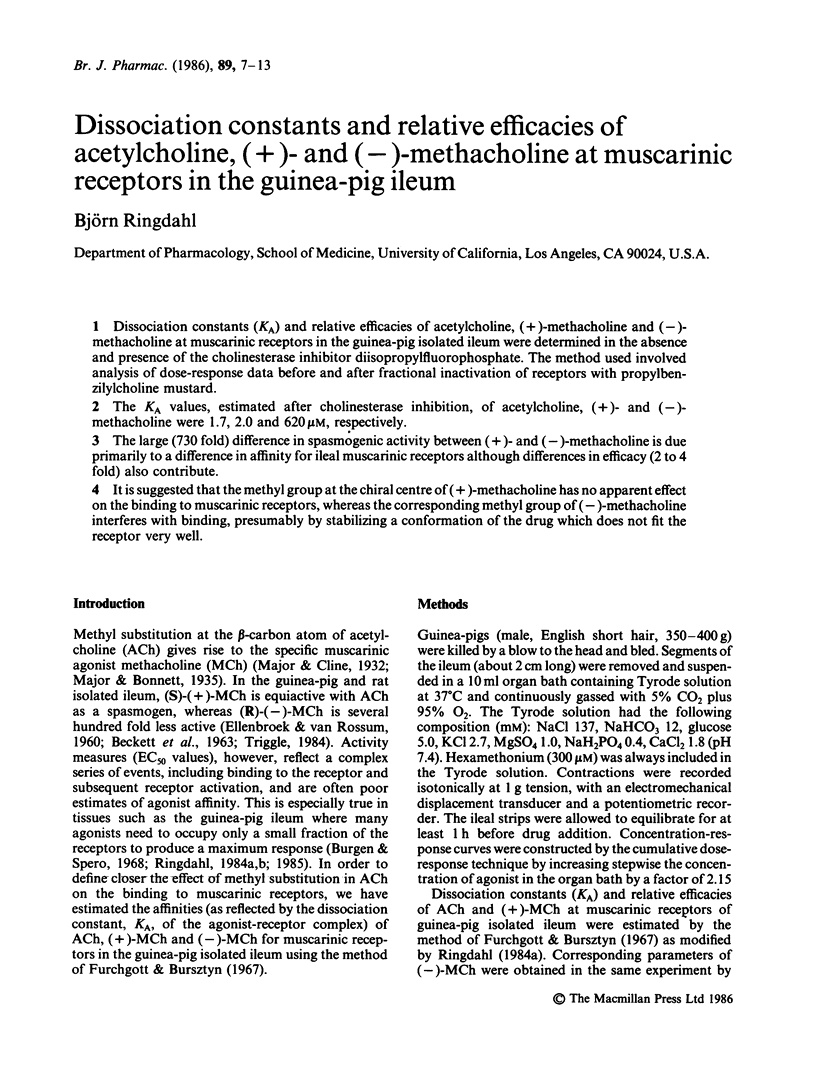
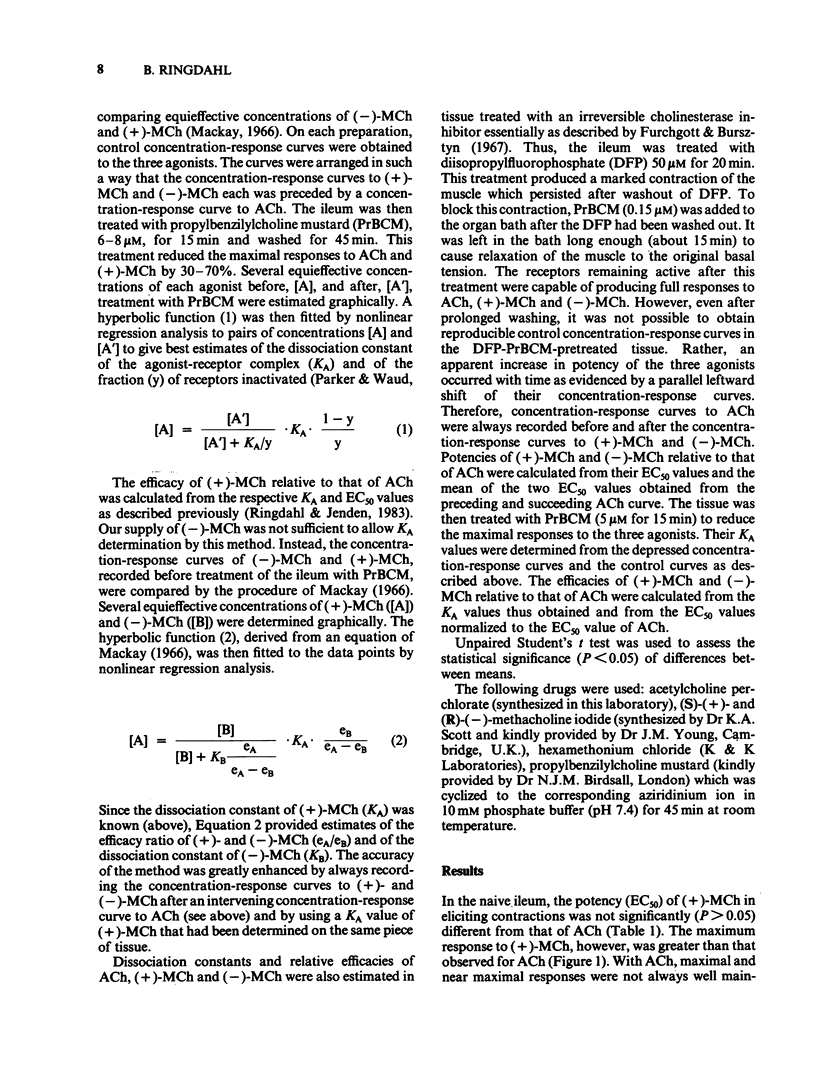
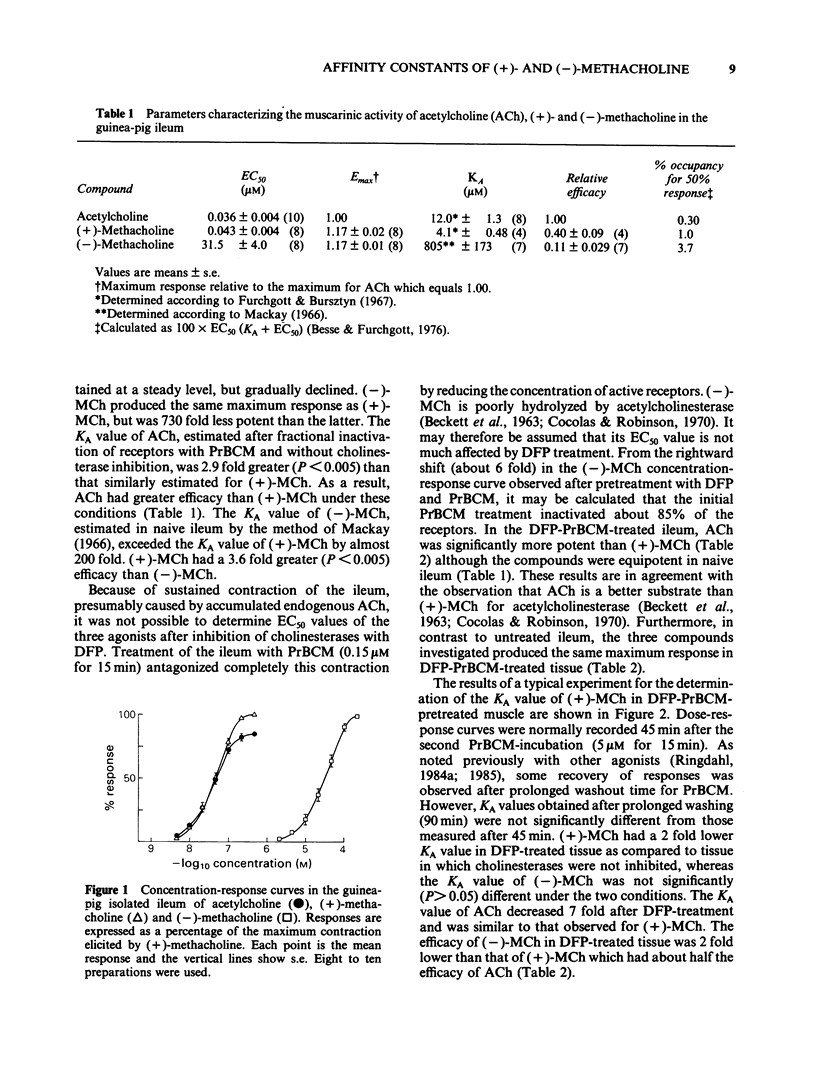
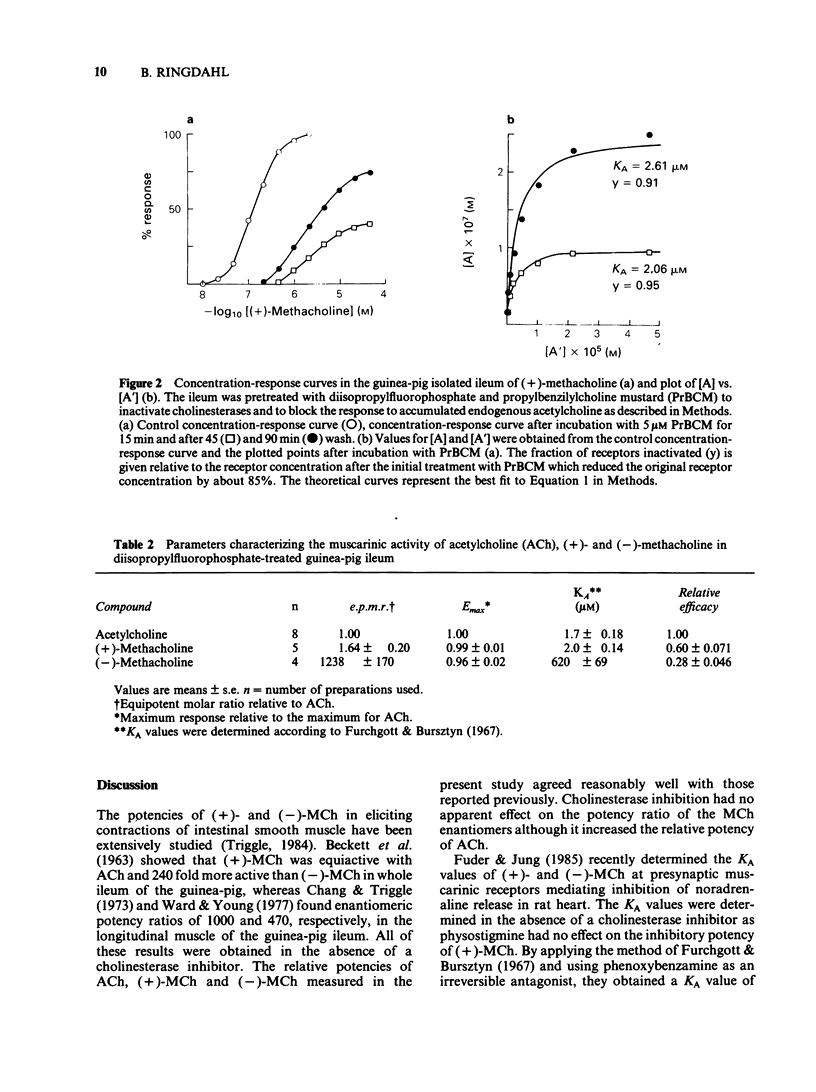
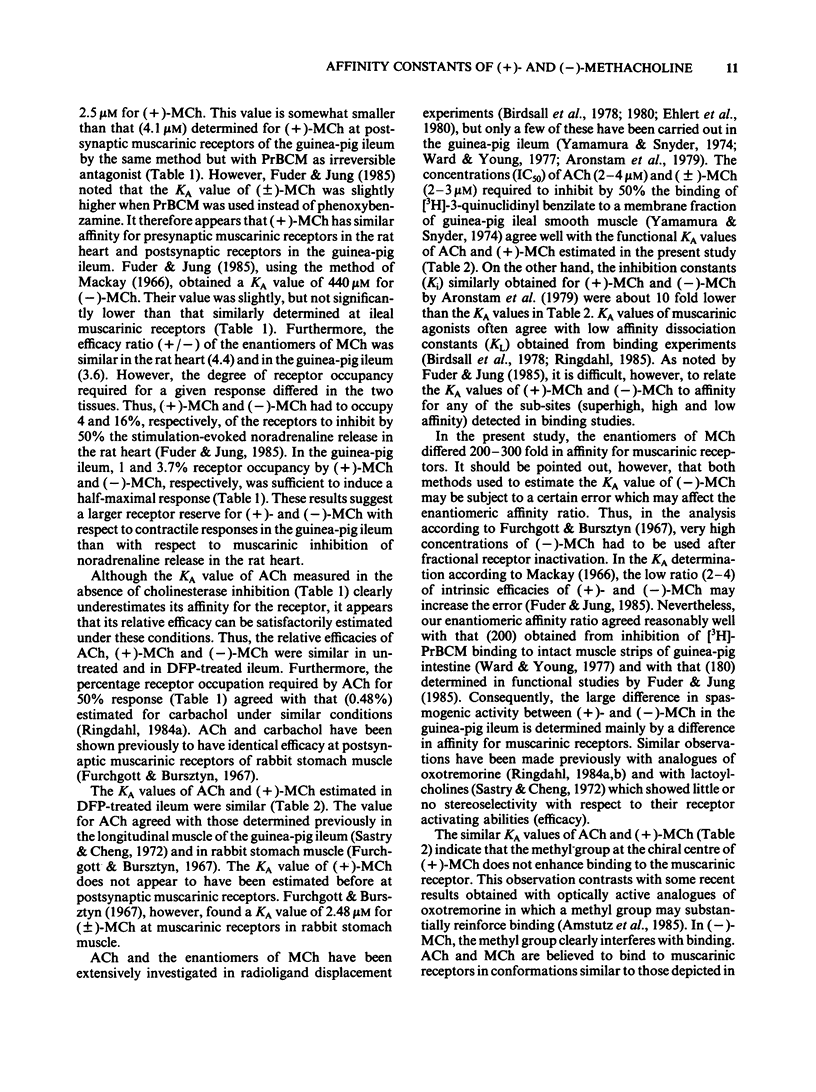
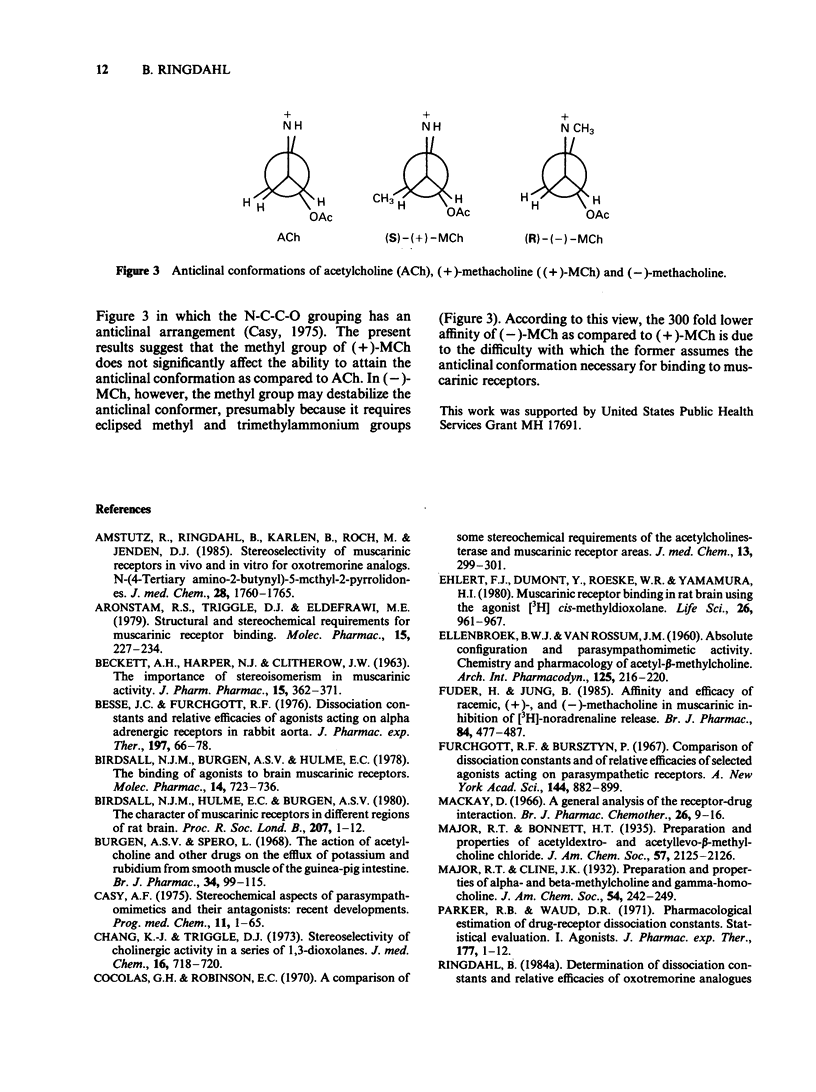
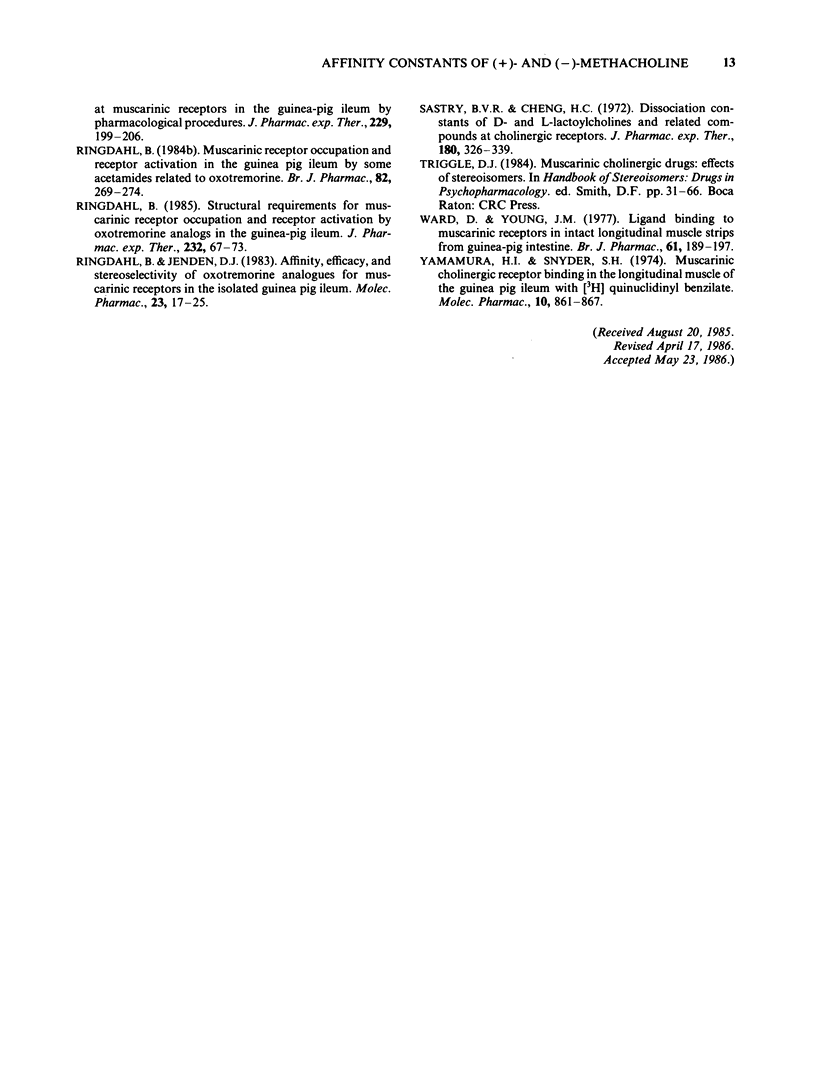
Selected References
These references are in PubMed. This may not be the complete list of references from this article.
- Amstutz R., Ringdahl B., Karlén B., Roch M., Jenden D. J. Stereoselectivity of muscarinic receptors in vivo and in vitro for oxotremorine analogues. N-[4-(tertiary amino)-2-butynyl]-5-methyl-2-pyrrolidones. J Med Chem. 1985 Dec;28(12):1760–1765. doi: 10.1021/jm00150a004. [DOI] [PubMed] [Google Scholar]
- Aronstam R. S., Triggle D. J., Eldefrawi M. E. Structural and stereochemical requirements for muscarinic receptor binding. Mol Pharmacol. 1979 Mar;15(2):227–234. [PubMed] [Google Scholar]
- BECKETT A. H., HARPER N. J., CLITHEROW J. W. The importance of stereoisomerism in muscarinic activity. J Pharm Pharmacol. 1963 Jun;15:362–371. doi: 10.1111/j.2042-7158.1963.tb12799.x. [DOI] [PubMed] [Google Scholar]
- Besse J. C., Furchgott R. F. Dissociation constants and relative efficacies of agonists acting on alpha adrenergic receptors in rabbit aorta. J Pharmacol Exp Ther. 1976 Apr;197(1):66–78. [PubMed] [Google Scholar]
- Birdsall N. J., Burgen A. S., Hulme E. C. The binding of agonists to brain muscarinic receptors. Mol Pharmacol. 1978 Sep;14(5):723–736. [PubMed] [Google Scholar]
- Birdsall N. J., Hulme E. C., Burgen A. The character of the muscarinic receptors in different regions of the rat brain. Proc R Soc Lond B Biol Sci. 1980 Feb 13;207(1166):1–12. doi: 10.1098/rspb.1980.0011. [DOI] [PubMed] [Google Scholar]
- Casy A. F. Stereochemical aspects of parasympathomimetics and their antagonists: recent developments. Prog Med Chem. 1975;11:1–65. doi: 10.1016/s0079-6468(08)70207-8. [DOI] [PubMed] [Google Scholar]
- Chang K. J., Triggle D. J. Stereoselectivity of cholinergic activity in a series of 1,3-dioxolanes. J Med Chem. 1973 Jun;16(6):718–720. doi: 10.1021/jm00264a037. [DOI] [PubMed] [Google Scholar]
- Cocolas G. H., Robinson E. C., Dewey W. L. A comparison of some stereochemical requirements of the acetylcholinesterase and muscarinic receptor areas. J Med Chem. 1970 Mar;13(2):299–301. doi: 10.1021/jm00296a034. [DOI] [PubMed] [Google Scholar]
- ELLENBROEK B. W., van ROSSUM J. Absolute configuration and parasympathomimetic activity. Chemistry and pharmacology of acetyl-beta-methylcholine. Arch Int Pharmacodyn Ther. 1960 Apr 1;125:216–220. [PubMed] [Google Scholar]
- Ehlert F. J., Dumont Y., Roeske W. R., Yamamura H. I. Muscarinic receptor binding in rat brain using the agonist, [3H]cis methyldioxolane. Life Sci. 1980 Mar 24;26(12):961–967. doi: 10.1016/0024-3205(80)90117-4. [DOI] [PubMed] [Google Scholar]
- Fuder H., Jung B. Affinity and efficacy of racemic, (+)-, and (-)-methacholine in muscarinic inhibition of [3H]-noradrenaline release. Br J Pharmacol. 1985 Feb;84(2):477–487. doi: 10.1111/j.1476-5381.1985.tb12932.x. [DOI] [PMC free article] [PubMed] [Google Scholar]
- Mackay D. A general analysis of the receptor-drug interaction. Br J Pharmacol Chemother. 1966 Jan;26(1):9–16. doi: 10.1111/j.1476-5381.1966.tb01805.x. [DOI] [PMC free article] [PubMed] [Google Scholar]
- Parker R. B., Waud D. R. Pharmacological estimation of drug-receptor dissociation constants. Statistical evaluation. I. Agonists. J Pharmacol Exp Ther. 1971 Apr;177(1):1–12. [PubMed] [Google Scholar]
- Rama Sastry B. V., Cheng H. C. Dissociation constants of D- and L-lactoylcholines and related compounds at cholinergic receptors. J Pharmacol Exp Ther. 1972 Feb;180(2):326–339. [PubMed] [Google Scholar]
- Ringdahl B. Determination of dissociation constants and relative efficacies of oxotremorine analogs at muscarinic receptors in the guinea-pig ileum by pharmacological procedures. J Pharmacol Exp Ther. 1984 Apr;229(1):199–206. [PubMed] [Google Scholar]
- Ringdahl B., Jenden D. J. Affinity, efficacy, and stereoselectivity of oxotremorine analogues for muscarinic receptors in the isolated guinea pig ileum. Mol Pharmacol. 1983 Jan;23(1):17–25. [PubMed] [Google Scholar]
- Ringdahl B. Muscarinic receptor occupation and receptor activation in the guinea-pig ileum by some acetamides related to oxotremorine. Br J Pharmacol. 1984 May;82(1):269–274. doi: 10.1111/j.1476-5381.1984.tb16467.x. [DOI] [PMC free article] [PubMed] [Google Scholar]
- Ringdahl B. Structural requirements for muscarinic receptor occupation and receptor activation by oxotremorine analogs in the guinea-pig ileum. J Pharmacol Exp Ther. 1985 Jan;232(1):67–73. [PubMed] [Google Scholar]
- Ward D., Young J. M. Ligand binding to muscarinic receptors in intact longitudinal muscle strips from guinea-pig intestine. Br J Pharmacol. 1977 Oct;61(2):189–197. doi: 10.1111/j.1476-5381.1977.tb08404.x. [DOI] [PMC free article] [PubMed] [Google Scholar]


